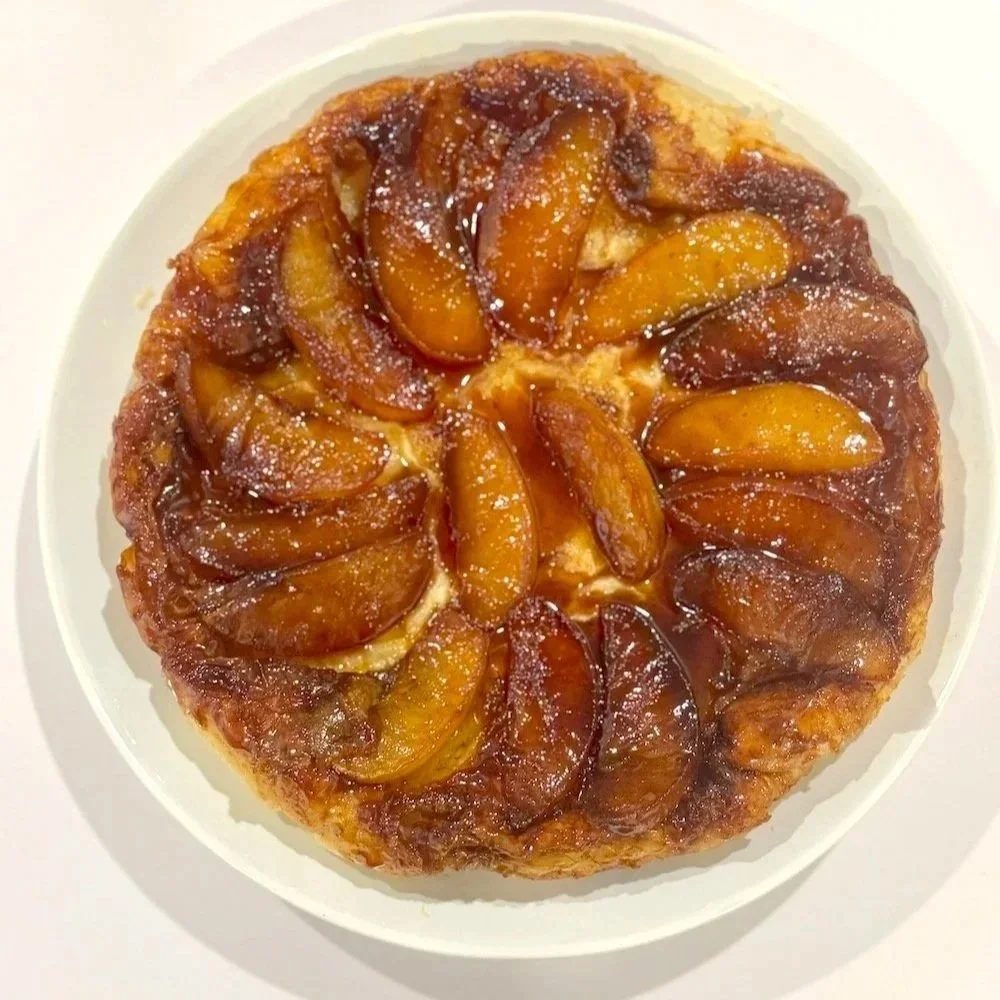Tarte Tatin
This post may contain affiliate links.
A classic French upside-down caramelized apple tart: simple, rustic, and completely enchanting.
There’s something magical about a tarte tatin. The way the apples slowly melt into amber caramel… the moment you flip the skillet and reveal the glossy top… the aroma that fills the kitchen. It’s the kind of bake that turns an ordinary weeknight into a tiny celebration.
WHAT YOU’LL NEED FOR TARTE TATIN
3-4 medium firm apples (Honeycrisp, Pink Lady or Granny Smith)
4 Tbsp unsalted butter
1/2 cup granulated sugar
Pinch of sea salt
1 tsp vanilla paste or extract
1 sheet good quality puff pastry, thawed but still cold.
INSTRUCTIONS
Measure and lay out all your ingredients.
2. Preheat oven to 400°F.
3. Peel, core and quarter the apples.
4. In an oven-safe skillet, melt the butter over medium heat. Sprinkle the sugar evenly across the butter and let it melt undisturbed. As it begins to bubble and turn golden, gently swirl the pan to help the caramel color evenly. Add vanilla and a pinch of sea salt
5. Tightly nestle the apples on top of the caramel. (I could have packed a lot more in my pan). Simmer for 10–12 minutes until the edges begin to soften and caramel thickens.
6. Lay puff pastry over the apples, tucking in the edges. Cut a couple of slits to vent steam.
7. Transfer skillet to oven and bake for 20-25 minutes until deeply golden.
8.Cool five minutes then carefully invert onto a plate. Delicious on its own, but you can serve tarte tatin with whipped cream or ice cream.
Storage:
Tarte tatin is best served the day it’s made. It can sit at room temperature for up to 6 hours loosely covered with foil. Store covered in refrigerator for up to 3 days. Reheat in the oven at 300°F for 10-12 minutes. The microwave works in a pinch but the pastry will soften. Freezing is not recommended.
Pro Tips:
Choose the right apples. Firm, tart, and structured apples hold up best. Great choices include Honeycrisp, Pink Lady, Granny Smith, Braeburn, Jonagold.
Don’t stir the caramel. Swirl the pan gently instead. Stirring encourages crystallization.
Use an oven-safe skillet with some weight. Cast iron is excellent; it develops a deeper caramel and keeps heat consistent.
Caramel should be deeply golden, not light. The flavor should be one shade shy of “almost burned.” That’s where the complexity comes from.
Pack the apples tightly. They shrink while cooking, so a snug arrangement makes the flip much more beautiful.
Make sure the puff pastry is cold before topping. A cooler pastry = better puff and flakiness.
Rest 5 minutes before flipping, not longer. Flip too early → the caramel is too thin. Flip too late → the caramel sets and sticks.
Notes:
This tart is meant to be rustic. Every single one looks a little different. That’s the charm and tradition of a tarte tatin.
The caramel might seem too dark but trust it. That deeper amber is what separates “sweet apples under pastry” from a true French tarte tatin.
It’s naturally elegant without extra garnish. But if you want to elevate it further:
dust with a touch of powdered sugar,
serve with crème fraîche, whipped cream or ice cream
or drizzle a bit of warm caramel around the plate.
✨ Let’s Bake Together
Loved this recipe?
Join The Gourmet Table, my weekly newsletter filled with French pastry tips, seasonal recipes, and elegant inspiration for your next celebration. Whether you’re baking for two or styling a dessert table for twenty, I’ll help you make it unforgettable.
📬 Sign up for the newsletter here →
📸 Follow along on Instagram @gourmetlayers for behind-the-bake moments, styling tips, and cookie cam magic.
💬 Tried this recipe? Leave a comment or tag me — I love seeing what you create





